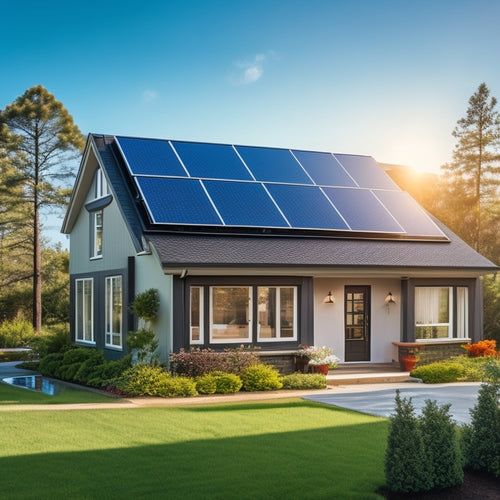
5 Tips for Seamless Electric Home Automation
Share
You're on the path to a seamless electric home automation system. Start by building a robust wireless infrastructure that can handle power and connectivity demands. Choose devices that work together seamlessly, considering hub compatibility and device types. Calculate your energy needs and prioritize efficiency to avoid overloading your electrical infrastructure. Design your system with scalability in mind, using modular designs and open standards. Finally, integrate your system with your solar system to maximize energy harvesting and minimize your carbon footprint. By following these essential tips, you'll access a convenient, efficient, and innovative home automation system - and that's just the beginning.
Key Takeaways
• Ensure a robust electrical infrastructure that can handle power and connectivity demands for seamless automation.
• Select devices that work together seamlessly, considering hub compatibility, power consumption, and voice assistant integration.
• Calculate total power consumption of devices and guarantee a reliable and efficient system to avoid overloading the electrical infrastructure.
• Design a scalable system that can adapt to future upgrades, using modular design and open standards for easy modifications.
• Integrate with a solar system to maximize energy harvesting and storage, and track energy usage patterns for optimization.
Start With a Solid Foundation
Your home's electrical infrastructure plays an important role in supporting your automation system. It is critical to ensure it can accommodate the increased demand for power and connectivity. A solid foundation is essential for a seamless automation experience, and it all starts with a robust wireless infrastructure.
This includes a reliable network topology that can handle the increased traffic and data exchange between devices. You'll want to verify that your network can support the added load of devices communicating with each other. A well-designed network topology will help prevent bottlenecks, dropped signals, and connectivity issues.
Consider investing in a mesh network system, which can provide a more reliable and robust connection. By building a strong foundation, you'll be able to enjoy the full benefits of home automation, from increased convenience to enhanced energy efficiency.
Choose the Right Devices
With a robust wireless infrastructure in place, you're now ready to select devices that will bring your automated home to life. This is where the fun begins! You'll want to choose devices that not only work seamlessly together but also provide a great user experience.
When selecting devices, consider the following factors:
| Device Compatibility | User Experience |
|---|---|
| Hub compatibility (e.g., Zigbee, Z-Wave) | Intuitive mobile app control |
| Device type (e.g., smart bulbs, thermostats) | Voice assistant integration (e.g., Alexa, Google Assistant) |
| Power consumption and energy efficiency | Customizable scenes and automation |
You'll want to make sure that your devices are compatible with your hub and each other, and that they provide a user-friendly experience. Consider devices that integrate with popular voice assistants and offer customizable scenes and automation. By choosing the right devices, you'll be able to create a seamless and enjoyable automated home experience that you'll love coming home to.
Consider Your Energy Needs
As you build your automated home, you'll need to take into account the power requirements of your devices to guarantee a reliable and efficient system. This means considering your energy needs to make sure that your automation system runs smoothly and doesn't overload your electrical infrastructure.
To do this, you'll need to calculate the total power consumption of your devices. Make a list of all the devices you plan to automate, including lights, thermostats, security cameras, and more. Then, research the power requirements of each device, including their voltage, amperage, and wattage. This will give you a clear picture of your overall energy needs.
Plan for Scalability Now
Having calculated your energy needs, you're now ready to plan for scalability, which involves designing an automation system that can adapt to future upgrades and additions. This is vital because it allows your system to grow with your needs, ensuring you don't have to rip and replace your entire setup when you want to add new features.
To ensure scalability, consider the following future-proofing strategies:
-
Modular Design: Break down your system into smaller, independent modules that can be easily swapped or upgraded without affecting the entire system.
-
Open Standards: Choose systems that adhere to open standards, making it easier to integrate new devices or technologies as they emerge.
-
Scalable Hardware: Select hardware that can handle increased loads or capacity as your system grows.
- Flexible Programming: Use programming languages and tools that allow for easy modifications and updates as your needs change.
Integrate With Your Solar System
You'll maximize the benefits of electric home automation by integrating it with your solar system, which can optimize energy harvesting and storage. This integration allows you to monitor and control your energy production and consumption in real-time, ensuring you're making the most of the energy you generate.
With system monitoring, you'll be able to track your energy usage patterns, identifying areas where you can reduce waste and optimize your energy harvesting. This data-driven approach enables you to make informed decisions about your energy usage, reducing your reliance on the grid and minimizing your carbon footprint.
Frequently Asked Questions
Can I Control My Automated Home With Voice Commands?
"Are you ready to be the master of your domain? You can indeed control your automated home with voice commands, using voice assistants like Alexa or Google Home, and crafting personalized command phrases that make your life easier."
Will Smart Devices Work With My Existing Home Wiring?
You'll likely need wiring upgrades to guarantee seamless connectivity, as your existing home wiring may not support the increased power demands of smart devices, especially if you have outdated circuit limitations.
Can I Automate My Outdoor Lighting and Security Cameras?
You can automate your outdoor lighting and security cameras by installing outdoor sensors that detect motion and adjust lighting accordingly, strategically placing cameras for best coverage, and integrating them with your smart home system.
How Do I Ensure My System Is Secure From Cyber Threats?
To safeguard your system, you'll want to implement robust Encryption Protocols and Network Segmentation, ensuring that your smart home devices are isolated from the internet and protected from potential cyber threats.
Are There Any Specific Wi-Fi Requirements for Automation Devices?
When setting up your smart home, you'll need a strong Wi-Fi connection to prevent congestion and network latency, ensuring seamless communication between devices; look for a router that can handle multiple devices and prioritize traffic efficiently.
Related Posts
-

10 Tips for Cleaner City Air With Scooters
By adopting a few simple habits, you can make a significant impact on reducing city air pollution with your scooter. ...
-

Planning for an Electric Vehicle-Friendly Urban Future
As you plan for an electric vehicle-friendly urban future, you'll need to integrate high-power charging stations, sma...
-

Solar Power Units Perfect for Homes
You're considering installing a solar power unit in your home, a decision that can notably reduce your reliance on tr...


